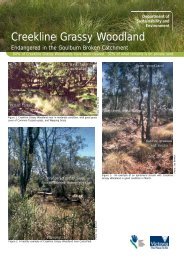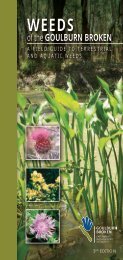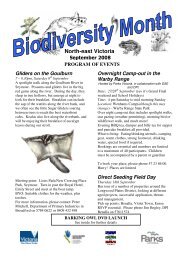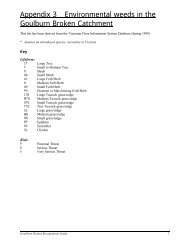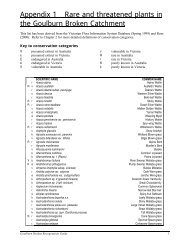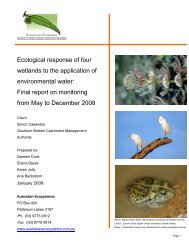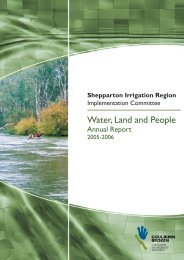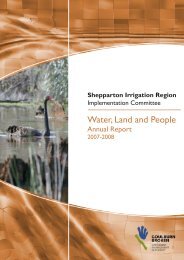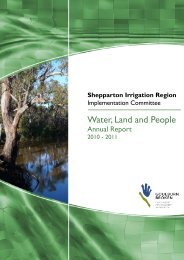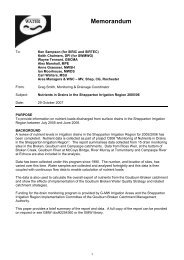Water, Land and People - Goulburn Broken Catchment ...
Water, Land and People - Goulburn Broken Catchment ...
Water, Land and People - Goulburn Broken Catchment ...
Create successful ePaper yourself
Turn your PDF publications into a flip-book with our unique Google optimized e-Paper software.
ACTIVITIES AND ACHIEVEMENTS<br />
36<br />
• The various types of Farm Program Incentives have<br />
been digitised to facilitate reporting <strong>and</strong> mapping;<br />
• Created map documents to help staff easily create<br />
spatial documents;<br />
• Provide technical support through telephone, email,<br />
site visits <strong>and</strong> one-on-one support;<br />
• Provide GIS information to support project <strong>and</strong><br />
<strong>L<strong>and</strong></strong>care group activities <strong>and</strong> reporting.<br />
Achievements <strong>and</strong> implications<br />
Spatial Information Sciences are building capacity for<br />
staff to use the tools to collect data in an efficient <strong>and</strong><br />
effective manner <strong>and</strong> give staff the confidence to create<br />
<strong>and</strong> underst<strong>and</strong> spatial data.<br />
This project allows Shepparton Irrigation Region<br />
<strong>Catchment</strong> Implementation Strategy support staff to<br />
create spatial products easily, collect data, store the data,<br />
easily access it <strong>and</strong> carry out spatial analysis of that data.<br />
This will also improve data quality over time, as well as<br />
enable data that might once have been seen only in table<br />
format to be presented in more easily understood map<br />
formats.<br />
Feasibility <strong>and</strong> sustainability of sub-surface<br />
drip irrigation in pasture production<br />
Background<br />
Ongoing water shortages <strong>and</strong> potential future reductions<br />
in water supply highlight the need to make best use of<br />
the available water. Sub-surface drip (SSD) irrigation can<br />
deliver water directly to the plant rootzone <strong>and</strong> thus<br />
reduce potential evaporation, runoff <strong>and</strong> drainage losses.<br />
Installation of SSD on dairy farms may also benefit regional<br />
water quality by reducing irrigation run-off. However, dairy<br />
farmers are unlikely to invest in SSD irrigation if they<br />
are not confident it can withst<strong>and</strong> cattle grazing <strong>and</strong> be<br />
economically viable.<br />
The project has established two field experiments located<br />
on two dairy farms in northern Victoria, testing how SSD<br />
performs on a ‘light’ <strong>and</strong> a ‘medium’ soil. The experiment<br />
is testing SSD design (tape spacing) <strong>and</strong> management<br />
(irrigation frequency) on pasture production <strong>and</strong> the<br />
pathways of water <strong>and</strong> solute movement.<br />
The three main objectives of this project are to:<br />
• Assess the practical <strong>and</strong> economic feasibility of SSD<br />
irrigation on dairy farms;<br />
• Evaluate the economic, environmental <strong>and</strong> social<br />
consequences of SSD irrigation on dairy farms, at both<br />
the farm <strong>and</strong> catchment scales;<br />
• Produce information about SSD irrigation on dairy<br />
farms for irrigators, irrigation service providers, <strong>and</strong><br />
irrigation extension <strong>and</strong> policy programs.<br />
Project activities<br />
Sub-surface Drip has maintained pasture production<br />
under grazing throughout the 2006-2007, 2007-2008 <strong>and</strong><br />
2008-2009 seasons. Pugging issues due to grazing have<br />
not occurred. The dry spring of 2006 showed that SSD<br />
can be used to germinate pasture on a medium soil, but<br />
SSD should not be used for pasture establishment on light<br />
soils. The results have also shown that the performance<br />
of SSD in achieving uniform spread of water <strong>and</strong> hence<br />
pasture growth is strongly influenced by soil structure <strong>and</strong><br />
water behaviour in that soil. On the medium soil, pasture<br />
production is unaffected by tape spacing or irrigation<br />
frequency, but on the light soil pasture production<br />
decreased as tape spacing increased from 0.6 to 1.0 <strong>and</strong><br />
1.4m (see Figure below).<br />
Results from these experiments are being used to show<br />
how SSD would work in other situations to identify the<br />
best combinations of system design <strong>and</strong> management for<br />
different soils. This will ensure the technology is used for<br />
maximum benefit. The implications for catchment level<br />
management of water <strong>and</strong> water quality are also being<br />
considered.<br />
A recent desktop economic analysis showed that SSD<br />
for pasture production could be profitable, provided<br />
that significant improvements in pasture production <strong>and</strong><br />
consumption <strong>and</strong> water savings are achieved, with the<br />
grown pasture highly valued. The investment is not wise if<br />
only water savings will be made.<br />
Achievements <strong>and</strong> implications<br />
The work to date has shown that while sub-surface drip<br />
irrigation can maintain pasture production under grazed<br />
conditions, it will not be suitable for every dairy farm. Its<br />
success is greatly dependant on the soil of the site. SSD<br />
will achieve most uniform irrigation <strong>and</strong> best pasture<br />
growth on duplex soils with low permeability subsoil.<br />
On light soils, gravity drainage beneath the dripper tapes<br />
allows too much downward movement of water which<br />
prevents uniform irrigation, reduces pasture production<br />
<strong>and</strong> leads to inefficient water use as water escapes<br />
below the plant root-zone. From an economic viewpoint,<br />
sufficient gains in pasture production <strong>and</strong> water savings<br />
over conventional irrigation would be needed for it to<br />
show a positive return on investment.



